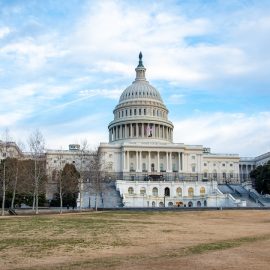

This article is an excerpt from the Shortform book guide to "The Shock Doctrine" by Naomi Klein. Shortform has the world's best summaries and analyses of books you should be reading.
Like this article? Sign up for a free trial here .
What is developmentalism? Which economic groups does developmentalism benefit? Why did corporations try to overthrow developmentalist policies?
Developmentalism is an economic school of thought which states that the best way for developing countries to speed up their growth is by developing their internal markets, limiting imports, and nationalizing certain industries. Developmentalism has had a tremendous impact on the growth of many Third World countries. However, the policies that helped the common people were hurting the rich and powerful.
In this article, you’ll learn about economic developmentalism, and corporations’ efforts to fight back against “its evils.”
What Is Developmentalism?
Developmentalism is an economic theory stating that the best way for developing countries to grow is to establish strong internal industries and raise government revenue by nationalizing certain resources like oil. In other words, industry and the government would support one another, and the entire country’s economy would prosper as a result. Developmentalism also called for high tariffs on imported goods to encourage “buying local.”
Developmentalism, combined with heavy government spending and strong social programs, was having enormous positive impacts on the economy and quality of life in many Third World countries. For example, Argentina had the largest middle class in South America during the Developmentalist period, while Uruguay boasted universal health care and a 95% literacy rate.
However, corporate interests and feudal landowners saw that the developmentalist policies were taking “their” land and money and giving it away to the lower classes. To counter the economic policies that were hurting their profits, corporations enlisted the help of American and British foreign policy groups to warn that developmentalist policies would lead to communism. In short, they wanted to push developing countries into the Us versus Them mindset of the Cold War: anything that wasn’t pure, unchecked capitalism was communism, and communism was evil.
Expanding the Cold War
In the interest of furthering the fight against “communism,” the CIA launched two coups d’etat against Iran and Guatemala—two countries whose economies were much more Keynesian than Stalinist.
In 1953 the CIA ousted Mohammad Mossadegh, an Iranian leader who had brought the nation’s oil company under government control. In doing so, the CIA returned power to Shah Mohammad Reza Pahlavi, who was more willing to cooperate with foreign companies.
Then, in 1954, the CIA overthrew President Jacobo Arbenz Guzman of Guatemala, allowing the United Fruit Company—a massive American corporation with a long history of violence and human rights violations—to operate unimpeded.
Those first coups happened relatively easily. However, developmentalism was much more entrenched in the Southern Cone of South America (Chile, Argentina, Uruguay, and Brazil, which together had some of the most advanced and successful developmentalist economies), and fighting it would take a bit more cunning.
Nixon’s Economic War on Chile
When then-president Richard Nixon heard that Salvador Allende had won the 1970 election in Chile—running on a platform of nationalizing major portions of the economy that were currently being run by corporations—he famously ordered CIA director Helms to “make the economy scream.”
Heeding the call to arms, powerful American corporations—who had large stakes in Chile’s phone service, mining operations, and other industries that would soon be bought up by the government—banded together to squeeze Chile’s economy. They planned to block US loans, stop buying anything from Chile for six months, and do whatever they could to make sure that no American money flowed into the country. They planned to make Allende capitulate by threatening him with total economic collapse.
But for all their efforts, Allende not only kept his office, but his party also gained even more support in the 1973 midterm elections. Clearly, the Chilean people strongly supported Allende’s socialist policies. Even if the corporations successfully ousted Allende, it seemed certain that someone just as progressive would come along to take his place.
In 1972 an explosive exposé revealed documents showing that the International Telephone and Telegraph Company (ITT) had conspired with the CIA and the US State Department to stop Allende from taking power—a plot that clearly failed, as Allende had taken office and still held it at the time of the exposé. Nonetheless, the Democratic-controlled Senate launched an investigation, and in 1973 released a damning report showing that ITT’s corporate interests had had a direct and substantial impact on US foreign policy toward Chile.
However, even supported by the highest powers in the US, the University of Chicago was unable to overthrow developmentalism in Chile. Clearly, the free market capitalists would need more extreme tactics to bring about the regime changes they dreamed of.
Despite the terrible repercussions, Chile was the beginning—the Chicago School’s first major victory against developmentalism and Keynesian economics.
Waging War on Developmentalism in South America
The Chilean plan would later be implemented in many other South American countries. In every case, it would be pushed through by a combination of government force and corporate wealth, and it would take place during some sort of national crisis. Eventually, every country that had once been a model of developmentalism—Brazil, Chile, Uruguay, and Argentina—would be under the control of a military junta with US backing.
Of these, Argentina’s implementation of Chicago economics may have been the most brutal and horrific. The Argentine generals who ousted Isabel Perón turned to Pinochet for advice on their next steps. They didn’t privatize everything quite as quickly as Pinochet had—for instance, the oil reserves and social security remained under government control, at least at first. Otherwise, though, the methods were much the same, as were the results: runaway inflation, soaring unemployment, starvation, and disease.
However, their methods of keeping order were a bit different. While Pinochet’s public massacres were extremely effective at keeping the population in line, they were a public relations nightmare. Since the entire point of Chicago economics was to trade with wealthy outsiders, it was counterproductive to have such a horrific reputation that other countries refused to trade with you.
Therefore, the Argentine generals settled on disappearances as their preferred means of eliminating opposition. Rather than publicly slaughtering people who spoke out against them, they’d simply kidnap those people. Sometimes they did so in secret, spreading the terrifying knowledge that the state could simply whisk anyone away at any time, with no warning. Other times they arrested people very publicly as a show of force. It’s estimated that some 30,000 Argentine citizens were taken during these years.
While not as dramatic as Pinochet’s methods, they were equally effective. Though everyone knew what was happening, they were too afraid to speak out—indeed, most would pretend that nothing was wrong. Argentines even have a phrase to sum up that combination of knowledge and denial: “We didn’t know what no one could deny.”

———End of Preview———
Like what you just read? Read the rest of the world's best book summary and analysis of Naomi Klein's "The Shock Doctrine" at Shortform .
Here's what you'll find in our full The Shock Doctrine summary :
- A study of the history of economic shock therapy
- How economic shock therapy gave rise to the disaster capitalism complex
- How communities are beginning to recover from the destructive shock treatments






